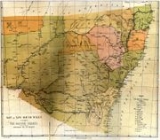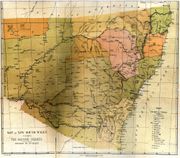
Gamilaraay language
Encyclopedia
The Gamilaraay or Kamilaroi (see below for other spellings) language is a Pama–Nyungan language of the Wiradhuric
subgroup found mostly in South East Australia. It was the traditional language of the Kamilaroi
people, but is now moribund—according to Ethnologue
, there were only 3 speakers left in 1997. However, there are thousands of people of mixed descent both within the native populations as well as immigrant populations, who identify themselves as Kamilaroi. Kamilaroi is also taught in some Australian schools.
Spellings of the name, pronounced ɡ̊aˌmilaˈɻaːj (listen) in the language itself, include:

A basic wordlist collected by Major Thomas Mitchell in February, 1832 is the earliest written record of Gamilaraay.
The Presbyterian missionary
William Ridley
studied the language from 1852 to 1856.
/wa/ is realized as [wo].
Initially, /wu/ and /ji/ may be simplified to [u] and [i].
Secondary stress falls on short vowels which are two syllables to the right or to the left of a stressed syllable.
s have entered Australian English
from Gamilaraay, including:
Wiradhuric languages
The Wiradhuric languages, or Central inland New South Wales, are a family of Pama–Nyungan languages of Australia. There are three languages:*Gamilaraay*Wiradhuri–Ngiyambaa**Wiradhuri**NgiyambaaAll are now moribund....
subgroup found mostly in South East Australia. It was the traditional language of the Kamilaroi
Kamilaroi
The Kamilaroi or Gamilaraay are an Indigenous Australian people who are from the area between Tamworth and Goondiwindi, and west to Narrabri, Walgett and Lightning Ridge, in northern New South Wales...
people, but is now moribund—according to Ethnologue
Ethnologue
Ethnologue: Languages of the World is a web and print publication of SIL International , a Christian linguistic service organization, which studies lesser-known languages, to provide the speakers with Bibles in their native language and support their efforts in language development.The Ethnologue...
, there were only 3 speakers left in 1997. However, there are thousands of people of mixed descent both within the native populations as well as immigrant populations, who identify themselves as Kamilaroi. Kamilaroi is also taught in some Australian schools.
Name
The name Gamilaraay means gamil-having, gamil being the word for "no". Other dialects and languages are similarly named after their respective words for "no". (Compare the division between Langue d'oïl and Langue d'oc in France, distinguished by their respective words for "yes".)Spellings of the name, pronounced ɡ̊aˌmilaˈɻaːj (listen) in the language itself, include:
- Camilaroi
- Kamalarai
- Kamilaroi
- Gamilaraay
- Gamilaroi
Geographic distribution

Dialects
- Yuwaalaraay
- Yuwaaliyaay (Euahlayi)
- Gunjbaraay
- Gawambaraay
- Wirayaraay (Wiriwiri)
- Walaraay
History
Southern Aboriginal guides led the surveyor John Howe to the upper Hunter River above present-day Singleton in 1819. They told him that the country there was "Coomery Roy [=Gamilaraay] and more further a great way", meaning to the north-west, over the Liverpool Range (see O'Rourke 1997: 29). This is probably the first record of the name.A basic wordlist collected by Major Thomas Mitchell in February, 1832 is the earliest written record of Gamilaraay.
The Presbyterian missionary
Missionary
A missionary is a member of a religious group sent into an area to do evangelism or ministries of service, such as education, literacy, social justice, health care and economic development. The word "mission" originates from 1598 when the Jesuits sent members abroad, derived from the Latin...
William Ridley
William Ridley (Presbyterian missionary)
William Ridley was an English Presbyterian missionary who studied Australian Aboriginal languages, particularly Gamilaraay....
studied the language from 1852 to 1856.
Vowel
| Front Front vowel A front vowel is a type of vowel sound used in some spoken languages. The defining characteristic of a front vowel is that the tongue is positioned as far in front as possible in the mouth without creating a constriction that would be classified as a consonant. Front vowels are sometimes also... |
Back Back vowel A back vowel is a type of vowel sound used in spoken languages. The defining characteristic of a back vowel is that the tongue is positioned as far back as possible in the mouth without creating a constriction that would be classified as a consonant. Back vowels are sometimes also called dark... |
|
|---|---|---|
| High | i, iː | u, uː |
| Low | a, aː | |
/wa/ is realized as [wo].
Consonants
| Peripheral Peripheral consonant In Australian linguistics, the peripheral consonants are a natural class encompassing consonants articulated at the extremes of the mouth: bilabials and velars. That is, they are the non-coronal consonants... |
Laminal Laminal consonant A laminal consonant is a phone produced by obstructing the air passage with the blade of the tongue, which is the flat top front surface just behind the tip of the tongue on the top. This contrasts with apical consonants, which are produced by creating an obstruction with the tongue apex only... |
Apical Apical consonant An apical consonant is a phone produced by obstructing the air passage with the apex of the tongue . This contrasts with laminal consonants, which are produced by creating an obstruction with the blade of the tongue .This is not a very common distinction, and typically applied only to fricatives... |
||||
|---|---|---|---|---|---|---|
| Bilabial Bilabial consonant In phonetics, a bilabial consonant is a consonant articulated with both lips. The bilabial consonants identified by the International Phonetic Alphabet are:... |
Velar Velar consonant Velars are consonants articulated with the back part of the tongue against the soft palate, the back part of the roof of the mouth, known also as the velum).... |
Palatal Palatal consonant Palatal consonants are consonants articulated with the body of the tongue raised against the hard palate... |
Dental | Alveolar Alveolar consonant Alveolar consonants are articulated with the tongue against or close to the superior alveolar ridge, which is called that because it contains the alveoli of the superior teeth... |
Post- alveolar Postalveolar consonant Postalveolar consonants are consonants articulated with the tongue near or touching the back of the alveolar ridge, further back in the mouth than the alveolar consonants, which are at the ridge itself, but not as far back as the hard palate... |
|
| Stop Stop consonant In phonetics, a plosive, also known as an occlusive or an oral stop, is a stop consonant in which the vocal tract is blocked so that all airflow ceases. The occlusion may be done with the tongue , lips , and &... |
b | ɡ | ɟ | d̪ | d | |
| Nasal Nasal consonant A nasal consonant is a type of consonant produced with a lowered velum in the mouth, allowing air to escape freely through the nose. Examples of nasal consonants in English are and , in words such as nose and mouth.- Definition :... |
m | ŋ | ɲ | n̪ | n | |
| Lateral Lateral consonant A lateral is an el-like consonant, in which airstream proceeds along the sides of the tongue, but is blocked by the tongue from going through the middle of the mouth.... |
l | |||||
| Rhotic Rhotic consonant In phonetics, rhotic consonants, also called tremulants or "R-like" sounds, are liquid consonants that are traditionally represented orthographically by symbols derived from the Greek letter rho, including "R, r" from the Roman alphabet and "Р, p" from the Cyrillic alphabet... |
r | ɻ | ||||
| Semivowel Semivowel In phonetics and phonology, a semivowel is a sound, such as English or , that is phonetically similar to a vowel sound but functions as the syllable boundary rather than as the nucleus of a syllable.-Classification:... |
w | j | ||||
Initially, /wu/ and /ji/ may be simplified to [u] and [i].
Stress
All long vowels in a word get equal stress. If there are no long vowels, stress falls on the first syllable.Secondary stress falls on short vowels which are two syllables to the right or to the left of a stressed syllable.
Gamilaraay words in English
Several loanwordLoanword
A loanword is a word borrowed from a donor language and incorporated into a recipient language. By contrast, a calque or loan translation is a related concept where the meaning or idiom is borrowed rather than the lexical item itself. The word loanword is itself a calque of the German Lehnwort,...
s have entered Australian English
Australian English
Australian English is the name given to the group of dialects spoken in Australia that form a major variety of the English language....
from Gamilaraay, including:
| Common nouns | ||
|---|---|---|
| Anglicised form | Gamilaraay | Meaning |
| bindi-eye, bindii Bindii Bindii, bindi, bindyi or bindi-eye may refer to the following plant species:* Soliva sessilis, also known as lawnweed, common soliva, and field burrweed... , bindies |
bindayaa | The burrs of several plant species that stick in one's feet. |
| brolga Brolga The Brolga , formerly known as the "Native Companion", is a bird in the crane family. The bird has also been given the name "Australian Crane", a term coined in 1865 by well-known ornithological artist John Gould in his Birds of Australia.The Brolga is a common gregarious wetland bird species in... |
burralga | A bird species, Grus rubicunda. |
| possibly budgerigar Budgerigar The Budgerigar , also known as Common Pet Parakeet or Shell Parakeet informally nicknamed the budgie, is a small, long-tailed, seed-eating parrot, and the only species in the Australian genus Melopsittacus... |
gidjirrigaa | A bird species, Melopsittacus undulatus. |
| Proper nouns | ||
| Anglicised form | Gamilaraay | Meaning |
| Kamilaroi Kamilaroi The Kamilaroi or Gamilaraay are an Indigenous Australian people who are from the area between Tamworth and Goondiwindi, and west to Narrabri, Walgett and Lightning Ridge, in northern New South Wales... |
gamilaraay | The Gamilaraay people or language. |
| Placenames | ||
| Anglicised form | Gamilaraay | Meaning |
| Boggabri Boggabri, New South Wales Boggabri is a small town on the Kamilaroi Highway in north-western New South Wales, Australia in Narrabri Shire, between Gunnedah and Narrabri. In 2006, the town had a population of 901 people.... |
bagaaybaraay | having creeks |
| Boggabilla Boggabilla, New South Wales Boggabilla is a small town in the far north of inland New South Wales, Australia in Moree Plains Shire. In 2006, the town had a population of 647 people.... |
bagaaybila | full of creeks |
| Collarenebri Collarenebri, New South Wales Collarenebri is a town with a population of 478 people in north western New South Wales, Australia. It is situated in Walgett Shire, on the Barwon River approximately 75 km northeast of Walgett and south west of Mungindi on the Gwydir Highway. It is from Pokataroo which was the nearest... |
galariinbaraay | having acacia Acacia Acacia is a genus of shrubs and trees belonging to the subfamily Mimosoideae of the family Fabaceae, first described in Africa by the Swedish botanist Carl Linnaeus in 1773. Many non-Australian species tend to be thorny, whereas the majority of Australian acacias are not... blossoms |

